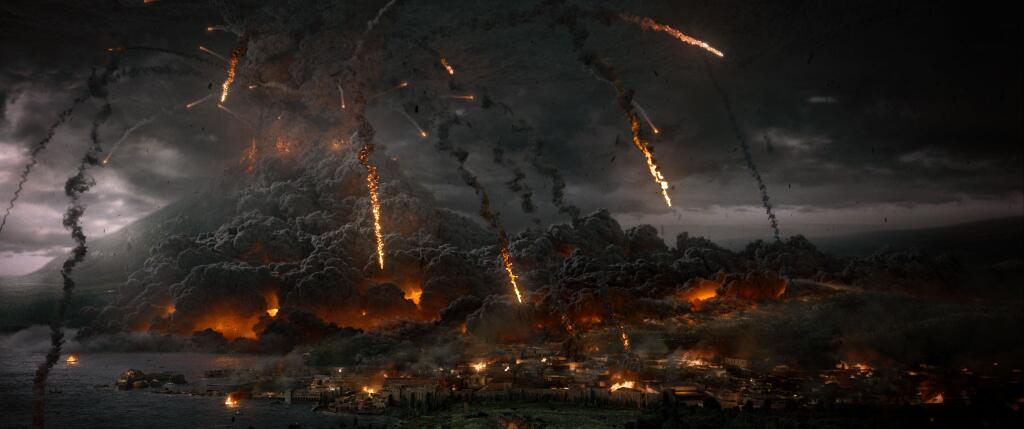‘Pompeii’ is an epic romantic historical film that is set in the ancient city of Pompeii, part of the Roman Empire that was destroyed by the eruption of Mount Vesuvius in 79 AD. While the explosion serves as a focal point of the 2014 film, it revolves around Milo (Kit Harington), a former slave turned gladiator and Cassia (Emily Browning), an Aristocrat’s daughter, who fall in love with each other and find themselves battling opposing forces and the eruption.
With Paul W.S Anderson at the helm, the ensemble cast of the film also comprises Carrie-Anne Moss, Adewale Akinnuoye-Agbaje, and Jessica Lucas, alongside Jared Harris and Kiefer Sutherland. The movie interweaves a romantic narrative and dramatic action sequences within the framework of a tragic event.
Pompeii is Partially Based on a True Story
‘Pompeii’ is partially based on a true story. The film, written by Janet Scott Batchler, Lee Batchler, and Michael Robert Johnson, is based on the eruption of stratovolcano Mount Vesuvius in southern Italy in 79 AD. On August 24, 79 AD, Vesuvius erupted with a level of ferocity never seen before. The unaware citizens, who were engaged in their daily tasks, were swallowed by ash, pumice, and rock, which quickly accumulated and buried the city and its residents. Pyroclastic surges—the lethal, swift currents of superheated gas and ash—swept through the streets, instantly incinerating anybody in their path, while a towering column of ash and gas rose into the sky, becoming the famous mushroom cloud.

Many were instantly preserved, forever entombed in whatever tasks they were doing during the impact. Pompeii was nearly fully submerged by several meters of volcanic rubble over the course of two days. As a result of this horrible tragedy, a thousand lives were reportedly lost. However, due to the rubble, the city was miraculously preserved, giving us a unique glimpse into life in ancient Rome. The preservation has allowed for many works to be made on the event, including this film.
What serves as the major source of reconstruction of historical events in the film are two letters. These letters were addressed to Roman historian Tacitus by Pliny the Younger, who is believed to have witnessed the eruption and recorded it in the letters. In an interview, Anderson explained his fascination with the letters, “We used old research. We relied on the letters of Pliny the Younger, who wrote very eloquently on what happened in Pompeii. What he wrote was so fantastical that his writings were discredited for quite a while because the Romans didn’t really understand what a volcano was.”
He further stated, “It is only as we have come to know what volcanoes do, and the kind of effects they have, that people have realized that he was writing about real events.” The film does take quite a few cinematic liberties but it accurately depicts the eruption of Vesuvius. The eruption which took place over stages is presented in detail, though the time frame is sped up to fit the movie’s narrative. Shedding light on the eruption sequence in the same interview, Anderson remarked, “In terms of what the volcano specifically does, all of that is based on a lot of photographs of real volcanic eruptions that have occurred in the last 10 years.”

The filmmaker added, “There has been a pretty big spike in volcanic activity over the last decade, and a lot of that has been captured on film. That is what we have based a lot of our [volcano] research on: a lot of footage of the volcano that exploded in Iceland recently, and a lot of the volcanic activity that has occurred in Japan, for example.” The film does take creative liberty in depicting the romance between Milo and Cassia, the city governor Severus’s daughter. The reality is that in a society with clear-cut class distinctions, it is improbable that a gladiator and an aristocratic woman would have been in a romantic relationship.
The characters of Milo and Cassia are actually based on something totally different. During an excavation of the ruins, the tragic cast known as “The Two Maidens” was found. The cast consisted of two people embracing each other while the ash swept over them. This served as an inspiration behind Milo and Cassia’s love story. Another character that, albeit fictional, is rooted in reality is Atticus (Adewale Akinnuoye-Agbaje). The character, who is a fellow gladiator and Milo’s friend in Pompeii, is based on the discovery of a large, well-built man who was assumed to be of African ancestry and found attempting to shield himself from the pyroclastic waves as they struck him.
The tsunami waves in the movie are another example of creative liberty. Although the massive event isn’t depicted in the movie, the volcano’s explosion did have some impact on the geography of the city. Even though volcanic eruptions can cause waves, in the film, Roman ships are shown to be hurled into the city, causing extensive damage, as well as being tossed around near the harbor. The same goes for the fireballs that appear to descend down on the city after the eruption, which mainly serves the purpose of heightening tension in the ending. In reality, there is no account of any such fireball shower.
Though the makers took some artistic license with respect to several factual details, ‘Pompeii’ does offer a quite authentical depiction of the magnitude and the severity of the eruption. The movie provides a gripping and realistic experience that lets viewers picture what it could have been like to see this catastrophic occurrence, though with a Hollywood twist. In the end, ‘Pompeii’ serves as a reminder of the strength of nature and the perseverance of humanity in the face of unfathomable adversity. Even if it might not be a true recounting of events, it still serves as an enthralling and engaging portrayal of a major historical catastrophe that remains a subject of worldwide fascination.
Read More: Historical Romance Movies That Are Just as Intense as Pompeii


You must be logged in to post a comment.